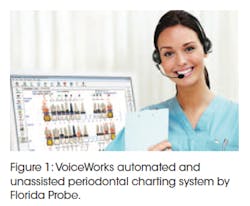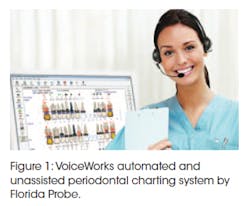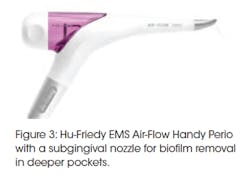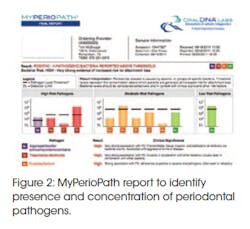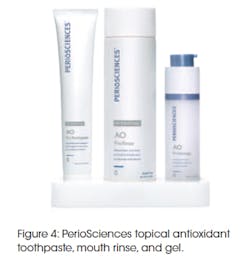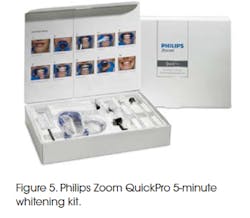Five Game Changers: Will they alter the course of dental hygiene treatment?
With the beginning of a new year, clinicians may be wondering what new technologies or services they should consider. As I reflected on this, it led me to consider what has the potential to become game changers for dental hygienists. I immediately considered the integration of laser technology, sharpen-free instruments, ergonomic operator chairs, CAMBRA, adjunctive devices for caries detection, and oral cancer screenings. Within minutes, I had a list of about 25 technologies and services that have completely altered how I practice dental hygiene from the day I started in 1979. So I decided to feature a few technologies I believe are underutilized or, in a few cases, even unknown by clinicians who have the potential to substantially alter patient care.
Automated and unassisted periodontal charting
In the world of dental hygiene, having another person enter data into the computer or record periodontal data is either a luxury or is uncommon. Dental hygienists everywhere seem caught in the time trap of laboriously entering the data or, in many cases, settling for spot probing and incomplete data collection. But automated technologies to collect and enter the data unassisted have been available to dental hygienists for decades, and when integrated, have the potential to help diagnose periodontal diseases in the earliest possible stages.
Dental R.A.T. (Remote Assisted Technology) is a foot-operated device that enables the clinician to enter periodontal data unassisted using hand-eye-foot coordination. It integrates to major software programs, automatically entering the data into periodontal charts, and also enables access to radiographs and other data, such as an intraoral camera in the patient’s record, with the touch of a foot pedal. Once numbers are entered via the foot pedal mouse, the computer audibly repeats the data so patients can hear it.
Florida Probe has three systems available for unassisted data collection, with the latest being VoiceWorks, seen in Figure 1. This is a voice-activated system that is easy to voice-train, easy to use in a noisy dental environment, and has a nice feature of being able to jump back to record data such as “delayed bleeding on No. 2 – distal” with a voice command. The GoProbe System enables clinicians to use their own probe, but with a compact keypad that can be worn on the arm, and data can be entered and transferred to the computer chart seamlessly. The Florida Probe System is a constant-force technology with 15 grams of pressure each measurement, and use of the automated probe removes all guesswork. No more wondering if the measurement is a 4.5 mm or 5 mm. It precisely measures pockets to 0.02 mm accuracy when placed in the pocket, and hygienists can depress a foot pedal to transfer the data automatically to the periodontal chart. All Florida Probe systems are audible so that the patient and clinician have the benefit of hearing the data as it is being recorded, and it works with all major software programs. Use of an automated periodontal charting system is a welcome game changer for clinicians and patients.
Subgingival air polishing
For years dental hygienists have laboriously and tediously scaled away soft and hard deposits from teeth using hand and power instruments, followed by polishing the teeth with a variety of abrasive pastes. While hard deposits still need to be removed mechanically with sharp instruments and power technology, removal of plaque biofilm can now be accomplished with low-abrasive powders and air polishing devices so that biofilm above and below the gum line can be safely and comfortably obliterated. The timesaving potential of subgingival air polishing is substantial compared to removing biofilm with curettes and ultrasonics in periodontal pockets. How much would your care be altered if you had an extra 10 minutes per appointment?
Subgingival air polishing technology is not uncommon in Europe where it was developed, and it is currently gaining traction in North America. Hu-Friedy EMS has portable and countertop devices that are specifically designed for use with low-abrasive powders, with a nozzle design that’s been proven to remove biofilm coronally and in shallow pockets up to 4 mm. It also has a flexible nozzle tip that targets biofilm in deeper pockets, as seen in Figure 3. In addition, this technology can use sodium bicarbonate powders, when desired, for stain and biofilm removal on enamel.
Acteon Satelec also has a portable device with interchangeable powder chambers and nozzle tips to accommodate coronal or subgingival air polishing. Coltene has a countertop unit designed for both coronal and subgingival air polishing. Low-abrasive glycine powder has shown to be safe for use on exposed root surfaces, esthetic materials, implants, and in periodontal pockets. There is a wide variety of high-speed evacuation tips available from manufacturers that effectively manage the aerosol spray, making this game changer comfortable for patients and clinicians.
Salivary diagnostics
Saliva is a potent vehicle to maintain homeostasis in the oral cavity, but it also provides valuable information to assist clinicians in customizing care for patients.
Identification of the presence of, as well as the threshold level of, pathogenic bacteria has the potential to guide clinicians to earlier intervention and determine the need for adjunctive antibiotic therapy. Sharing salivary diagnostic information with patients’ physicians can also assist in comanagement for patients with other chronic illnesses.
OralDNA Laboratories provides the MyPerioPath test, which identifies the type and concentration of specific periodontal pathogens using a sample of the patient’s saliva. A corresponding report is provided based on DNA information to help clinicians make clinical decisions for therapy and maintenance, as seen in Figure 2. Identification of destructive pathogens such as P. gingivalis and F. nucleatum are sometimes the deciding factors regarding when to provide nonsurgical treatment in otherwise borderline cases. Repeating the pathogen test following therapy ensures pathogens are eliminated or well below the threshold level, and along with the absence of clinical signs of infection, these serve as objective end points for therapy.
Approximately 30% of the population appears to have a genetic predisposition to periodontal disease, and approximately 50% of the variance in disease progression is related to an overexpression of genetic markers such as Interleukin-1 (IL-1). Therefore, identifying whether or not a patient possesses a heritable increased risk for periodontal destruction guides clinical decisions of when to treat, when to refer, and provides motivation for patients to reduce risk factors. For example, a patient that has prediabetes and is IL-1 positive has a greater risk of periodontal destruction than a patient that has prediabetes and is IL-1 negative. A patient at higher risk could benefit from more frequent preventive care even before signs of periodontal disease are present. OralDNA Labs provides the MyPerioID genetic test for Interleukin-6 (IL-6), and Interleukin Genetics provides the PerioPredict genetic test for IL-1. Some insurance companies have started using the results of genetic testing of IL-1 to correlate to intervals for preventive care.
Salivary diagnostics are also in place to identify HPV infections from OralDNA Labs, and a new test called SaliMark by PeriRx identifies biomarkers for oral squamous cell carcinoma. Salivary diagnostics are game changers that are ever changing as more information is gleaned from our patients’ saliva samples.
Topical antioxidants
Never before has there been a product with such a wide variety of clinical applications as that of topical antioxidants. Due to the ability to reduce oxidative stress and inflammation and help promote healing, topical antioxidants have been shown to be beneficial for xerostomia, management of geographic tongue, lichen planus, osteonecrosis of the jaw, peri-impantitis, gingivitis, periodontal infection, aphthous ulcers, nicotinic stomatitis, post-radiation treatment, and post-surgical healing. Data and clinical case studies also indicate that topical antioxidants may have a potential role in the prevention of conditions such as oral cancer and other inflammatory conditions in which increased oxidative stress is a factor.
Blazing the trail in the area of topical antioxidants is the company PerioSciences, Inc. Their signature product is an antioxidant gel that is applied directly to oral tissue and mucosa. They have also launched toothpastes and mouth rinses that incorporate natural antioxidants, as seen in Figure 4. Rather than a single antioxidant providing therapeutic benefit, these products combine various antioxidants — such as phloretin and ferulic acid — that possess a synergistic effect, along with essential oils that provide antibacterial activity. Periosciences has oral care kits that combine AO ProVantage topical antioxidant gel with mouth rinses and toothpastes that target a variety of conditions such as sensitivity and xerostomia. Topical antioxidants do not substitute the need for natural antioxidants from the diet or even supplemental antioxidants when indicated, but rather target specific inflammatory conditions inside the oral cavity, and can easily be incorporated into treatment protocols.
Another company that features antioxidants in their debriding mouth rinse and serum is Triology. The various antibacterial agents and antioxidants reduce pathogenic bacteria, and when the serum is applied to diseased pockets, it creates a microfoaming action to help flush out bacteria and soothe the tissue.
A significant game changer for me has been the replacement of chlorhexidine rinse with topical antioxidants, which have a noticeable pro-healing effect minus the impact of staining or supragingival calculus accumulation.
Prophylaxis whitening
What percentage of your patients wish their teeth were noticeably whiter when they leave the dental office following a prophylaxis, or even a periodontal maintenance appointment? This category of game changers I call “prophylaxis whitening” based on the fact that dental hygienists can now incorporate whitening procedures directly into their preventive appointments with very little time required. POPWhite has launched a whitening prophylaxis paste called POPWhite with a unique violet-dye composition called Viocin. When applied as a paste to discolored teeth, the violet counteracts or helps to cancel out the yellowish hues. The Viocin technology is also available in a take-home whitening kit and in a mouth rinse, with toothpaste soon to follow.
In keeping with the idea of whitening within the context of a routine dental hygiene visit, Philips Zoom launched a novel 5-minute whitening varnish called QuickPro, as seen in Figure 5, that can be applied to patients’ teeth at the end of their prophylaxis visit. The process involves a two-step technology using a 20% hydrogen peroxide gel, which is applied and then sealed with a varnish that hardens on the tooth surface. Patients are able to leave the dental hygiene appointment with the QuickPro whitening varnish having dried on their teeth. After 30 minutes, the patient brushes the varnish off and has whiter teeth. Philips Zoom and other companies also provide whitening pens for touch-ups, but being able to include a whitening treatment in the dental hygiene visit could be just the game changer needed to motivate patients to keep their appointments!
These five game changers have the potential to shift some of your paradigms, customize care to your patients, and enable you to practice more comprehensively and efficiently. So, what are you waiting for?
KAREN DAVIS, RDH, BSDH, is the founder of Cutting Edge Concepts, an international continuing education company, and practices dental hygiene in Dallas, Texas. She is an independent consultant to the Philips Corp., Interleukin Genetics, and Periosciences, and she serves on the review board for Dental-antioxidants.com. She can be reached at [email protected].
